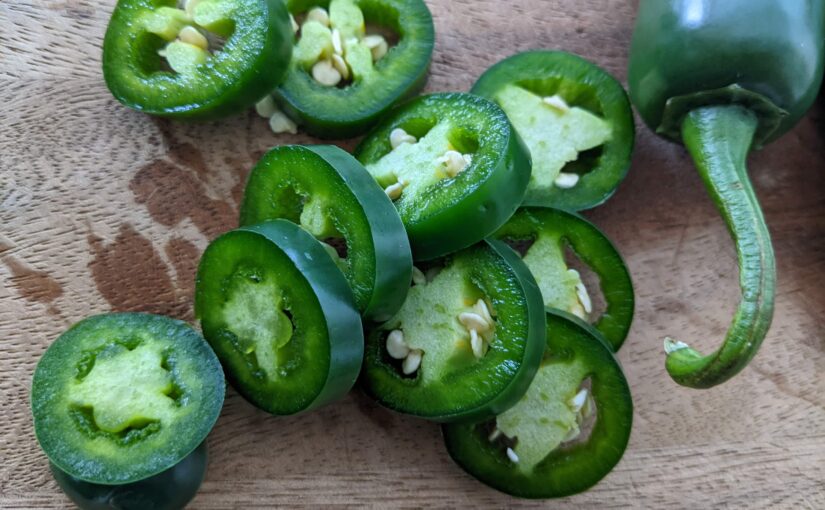This week my CSA share came with 1 tromboncino squash (a new to me vegetable), 2 eggplants, 1 basket of cherry tomatoes, several potatoes, several pounds of peaches, a half pound of mushrooms, 4 cups of basil, several bell peppers, 1 pound of tomatillos, 1 cantaloupe, and several large onions. In addition to this, I also picked about ten pounds of tomatoes and 2 pounds of raspberries at a local farm, and I harvested a few cups of chokecherries from some trees in my yard and 2 zucchinis from my garden. This is how I made sure all of the produce got used in our meals.
Continue reading CSA Sample Meal Plan (Mid Summer)Category: Food
When Life Gives You Green Tomatoes
Last week brought a beautiful and intense thunderstorm, followed by hail and an abundance of rain. The storm brought much needed moisture, but also knocked most of our green tomatoes from their plants. Not wanting to waste the food I’ve spent the last several months cultivating, I got to work finding a way to use the produce.
Continue reading When Life Gives You Green TomatoesCSA Sample Meal Plan (Early Summer)
Buying a share of a CSA, or community-shared agriculture, is one way people may choose to boost their local economy and eat more seasonal and local fruits and vegetables. A CSA provides a package of locally grown produce once a week or every other week during the growing season. The produce is fresh and nourishing, but can also be unfamiliar. I encourage you to see the new vegetables as a fun challenge rather than a daunting prospect, but I also understand that having examples of how to use new vegetables may be beneficial. I will explain to you how I used everything that came in my most recent CSA share, to hopefully inspire some ideas of how to use produce you may find in a CSA box in the early summer.
Continue reading CSA Sample Meal Plan (Early Summer)Weeknight Dinner Meals
I’ve said in a past post to always plan your meals for the week with your schedule in mind. That being said, some days get away from us and we need dinner now if we’re going to avoid going out to eat. That’s okay, life happens. So here are my tips for making healthy meals at home even when things aren’t going according to plan.
Continue reading Weeknight Dinner MealsUsing Dried Beans
I love beans. They’re so versatile, inexpensive, and satisfying. I cook up a large batch of dried beans several times per month and use those beans as the base of many meals. Even if I haven’t thought through a full meal plan, I know that I’ll be satisfied with something as simple as some black or pinto beans and cashew cheese on a tortilla or masa cake.
Continue reading Using Dried BeansReducing Food Waste (After Purchasing)
When we waste less food, we need less of it per person to sustain us. In reducing the amount of food each person requires we can reduce the land area needed to grow food, and we can potentially let that space go wild once more. We can dedicate more space to its natural and historic purpose, resulting in less flooding, buffer zones that can help reduce the impact of natural disasters, and more green space for local and migratory animals. This causes land to be more resilient to changing weather, and more capable of capturing carbon, an essential element in reducing the effects of climate change.
Continue reading Reducing Food Waste (After Purchasing)Reducing Food Waste (Planning and Purchasing)
Food waste is an issue that must be addressed to help combat climate change. It is estimated that 33% of food intended for human consumption is wasted in the US, most of which goes to the landfill. Once in the landfill, this food cannot break down properly and thus produces methane, a greenhouse gas far more potent than carbon dioxide. The US Environmental Protection Agency estimates that food waste in America produces the greenhouse gas equivalent of 42 coal-fired power plants, or 170 million metric tons of carbon dioxide equivalent. Yikes.
Continue reading Reducing Food Waste (Planning and Purchasing)Planting the Garden
The past few weekends have been spent planting seeds, seedlings, and fruit trees. Sprouts have already started to emerge where the seeds were planted, and the fruit trees and seedlings seem to be happy in their new home.
Continue reading Planting the GardenCooking with Food Waste (Spring)
My kids harvested quite a lot of radishes and green garlic from our CSA farm this past week. They were so excited about the process it was hard to limit their picking. Once we were home though, we got to work figuring out just how to use the bounty before us.
Continue reading Cooking with Food Waste (Spring)Pickling Jalapeños
About a month ago I decided I wanted to pickle my own jalapeños. Since I make my own cashew-based queso now, I go through a lot more pickled jalapeños than I used to. Plus, they’re delicious on nachos, and I will happily find any excuse to eat more nachos.
Continue reading Pickling Jalapeños








